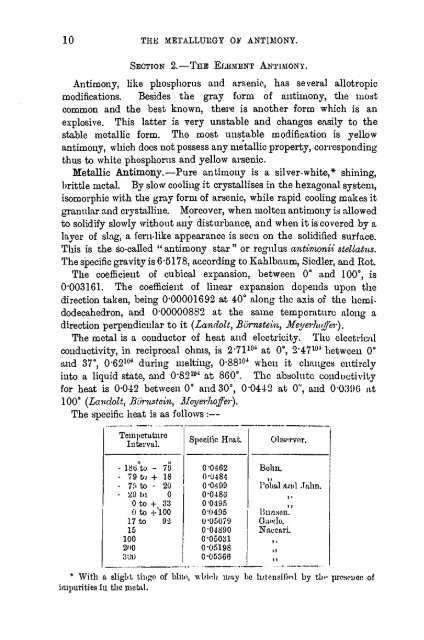antimony - Sciencemadness.org
antimony - Sciencemadness.org
antimony - Sciencemadness.org
You also want an ePaper? Increase the reach of your titles
YUMPU automatically turns print PDFs into web optimized ePapers that Google loves.
10 THE METALLURGY OX ANTIMONY.<br />
SECTION 2.—THE ELEMENT ANTIMONY.<br />
Antimony, like phosphorus and arsenic, has several allotropic<br />
modifications. Besides the gray form of <strong>antimony</strong>, the most<br />
common and the best known, there is another form which is an<br />
explosive. This latter is very unstable and changes easily to the<br />
stable metallic form. The most unstable modification is yellow<br />
<strong>antimony</strong>, which does not possess any metallic property, corresponding<br />
thus to white phosphorus and yellow arsenic.<br />
Metallic Antimony.—Pure <strong>antimony</strong> is a silver-white,* shining,<br />
brittle metal. By slow cooling it crystallises in the hexagonal system,<br />
isomorphic with the gray form of arsenic, while rapid cooling makes it<br />
granular and crystalline. Moreover, when molten <strong>antimony</strong> is allowed<br />
to solidify slowly without any disturbance, and when it is covered by a<br />
layer of slag, a fern-like appearance is seen on the solidified surface.<br />
This is the so-called " <strong>antimony</strong> star " or regulus antwionii stellatus.<br />
The specific gravity is 6*5178, according to Kahlbaum, Siedler, and Eot.<br />
The coefficient of cubical expansion, between 0° and 100°, is<br />
0*003161. The coefficient of linear expansion depends upon the<br />
direction taken, being 0*00001692 at 40° along the axis of the hcmidodecahedron,<br />
and 0*00000882 at the same temperature along a<br />
direction perpendicular to it (La,7idolt, Bernstein, Meyerhoffer).<br />
The metal is a conductor of heat and electricity. The electrical<br />
conductivity, in reciprocal ohms, is 2*71 104 at 0°, 2*47 104 between 0°<br />
and 37°, 0*62 104 during melting, 0*88 104 when it changes ontirely<br />
into a liquid state, and O'SS 10 ' 1 at 860°. The absolute conductivity<br />
for heat is 0*042 between 0° and 30°, 0*0442 at 0°, and 0*0396 at<br />
100° (Landolt, Burnstein, Meyerhoffer).<br />
The specific heat is as follows :—<br />
Temperature<br />
Interval.<br />
-186°to - 79<br />
- 79 to + 18<br />
- 7f> to - 20<br />
- 20 to 0<br />
0 to 4- 33<br />
0 to H-'lOO<br />
17 to 92<br />
15<br />
100<br />
2f»0<br />
300<br />
Specific Heat<br />
0-0462<br />
0*0484<br />
0*0499<br />
0*0486<br />
0-0495<br />
0*0495<br />
0*05079<br />
0*04890<br />
0*05031<br />
0*05198<br />
0*05366<br />
Observer.<br />
Bolm.<br />
Pobal and Jalm.<br />
Hun sen.<br />
Gawlo.<br />
Naccuri.<br />
* With a slight tinge of blue, -which may be iiitonyifuul by the prespneo of<br />
impurities in the metal.
















